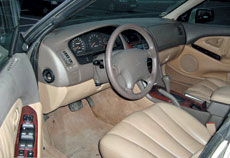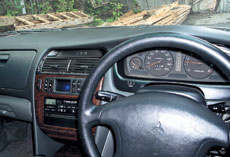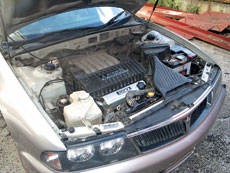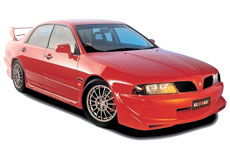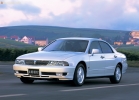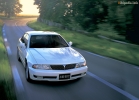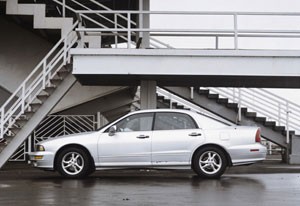Test drive Mitsubishi Diamante 1996 - 2004
A diamond without cut
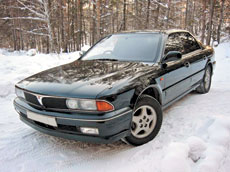 Perhaps the most common in Russia cars of the right-handed steering wheel is Toyota Mark II/Chaser/Cresta in the 90th and 100th bodies. But they are much more expensive than their analogues and, moreover, is much more boring in design. Are there really more beautiful and at the same time more affordable models of other manufacturers is so worse? For example, Mitsubishi Diamante?
Perhaps the most common in Russia cars of the right-handed steering wheel is Toyota Mark II/Chaser/Cresta in the 90th and 100th bodies. But they are much more expensive than their analogues and, moreover, is much more boring in design. Are there really more beautiful and at the same time more affordable models of other manufacturers is so worse? For example, Mitsubishi Diamante? Actually, Diamante is not a Japanese product at all, but Australian! It is there that the right -handed steering and left -handed cars, which are leaving, including in the United States, are collected. We had this car, for the first time represented in 1995, was also once known: the previous generation model was sold quite officially under the name Mitsubishi Sigma, and it even gained some kind of distribution. So why is the new version so unpopular?
Certainly not because of appearance! In appearance, the diamond is quite harmonious and pleasant: even today it looks fresh and solidly so many years after the debut. This is very facilitated by the solution, apparently, spied on the marco-shaped door glass without a framework. Most often
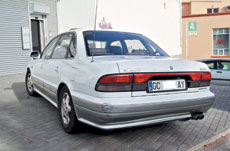 you can meet the sedan beloved by the Russians. Universals are only with the right wheel, and in our market they are a huge rarity. I am glad that the body as a whole is not subject to corrosion, but this is perhaps all its virtues. Firstly, some machines rot cups of racks. Secondly, the Diamante electrician is considered unreliable. It is believed that the source of the problems is that there is simply a lot of it. In principle, there are many models that are very saturated with equipment, distinguishes this kind of vulnerability, but after all other Japanese cars there are many servo drives, etc. Why do no one scolds them for frequent problems? It is worth noting that it is undesirable to discard the terminal from the battery (you never know, you want to weld a new muffler). You will have to train automatic transmission (it is adaptive), as well as programmatic lowering and lifting the windows.
you can meet the sedan beloved by the Russians. Universals are only with the right wheel, and in our market they are a huge rarity. I am glad that the body as a whole is not subject to corrosion, but this is perhaps all its virtues. Firstly, some machines rot cups of racks. Secondly, the Diamante electrician is considered unreliable. It is believed that the source of the problems is that there is simply a lot of it. In principle, there are many models that are very saturated with equipment, distinguishes this kind of vulnerability, but after all other Japanese cars there are many servo drives, etc. Why do no one scolds them for frequent problems? It is worth noting that it is undesirable to discard the terminal from the battery (you never know, you want to weld a new muffler). You will have to train automatic transmission (it is adaptive), as well as programmatic lowering and lifting the windows. And what about inside? There is no better: interesting design, competent color scheme, good decoration materials, as well as rich equipment (climate control and multivis, so called a touch screen, with which you can control additional equipment,
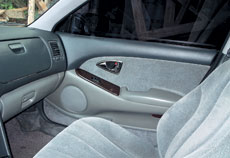 it is present in many copies) Diamante interior is made very pleasant. The spaces inside, in principle, are enough, but the sound insulation is mediocre (including due to glasses without frames).
it is present in many copies) Diamante interior is made very pleasant. The spaces inside, in principle, are enough, but the sound insulation is mediocre (including due to glasses without frames). On the go, no miracles from Diamante should be expected, although it is difficult to reproach it. The accelerated dynamics is quite satisfactory with almost any engine, and the suspension combines decent controllability with really good smoothness (rear-wheel drive Toyota business class is noticeably tougher). However, the brakes could be better: in principle, there is enough effectiveness, but when heated, it quickly disappears. In general, a good option for driving along the highway: quite decent stability on a straight road.
But from this moment we begin to list the main claims to this car. The appearance, salon, running qualities with this are all in order. But the operational properties cause questions. And the point is not that spare parts and consumables are rare and expensive. The fragility of this machine, which others call the most unsuccessful Mitsubishi model, is alarming.
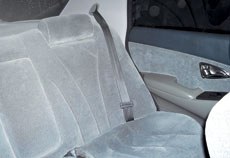 The gamut of the engines opens a 2.5-liter 6A13 unit with a capacity of 170 liters. with., which has no soreness of the GDI direct injection system, which showed itself, unlike the D4 system from Toyota, extremely unreliable. The rest of the GDI engines are equipped with: a 2.5-liter 6G73 with a capacity of 200 liters. s., and three -liter 6G72 with a capacity of 230 to 270 liters. With. (depending on execution). There is a 3.5-liter V6 with a capacity of 208 liters. with., But it can be found only under the hood of American specimens (very, by the way, rare in our market, and in the States itself, too). Why don't GDI like it? The main reason these engines are extremely demanding on the quality of the fuel used. The 98th and exclusively with proven gas stations are recommended. If you neglect this rule, then a high pressure fuel pump is out of order is very, by the way, an expensive part! The fact that she was still covered, can be judged by the unstable operation of the engine at idle. There are no other serious problems with motors. However, it should still be borne in mind that Mitsubishi (as, by the way, Honda) prefers timely maintenance using only high-quality materials.
The gamut of the engines opens a 2.5-liter 6A13 unit with a capacity of 170 liters. with., which has no soreness of the GDI direct injection system, which showed itself, unlike the D4 system from Toyota, extremely unreliable. The rest of the GDI engines are equipped with: a 2.5-liter 6G73 with a capacity of 200 liters. s., and three -liter 6G72 with a capacity of 230 to 270 liters. With. (depending on execution). There is a 3.5-liter V6 with a capacity of 208 liters. with., But it can be found only under the hood of American specimens (very, by the way, rare in our market, and in the States itself, too). Why don't GDI like it? The main reason these engines are extremely demanding on the quality of the fuel used. The 98th and exclusively with proven gas stations are recommended. If you neglect this rule, then a high pressure fuel pump is out of order is very, by the way, an expensive part! The fact that she was still covered, can be judged by the unstable operation of the engine at idle. There are no other serious problems with motors. However, it should still be borne in mind that Mitsubishi (as, by the way, Honda) prefers timely maintenance using only high-quality materials. Unfortunately, a four -speed automatic box is also a problematic place for Diamante. It happens that the car at one point, due to poor-quality oil, just stops going to go. The dirt clogs the pump, which at first simply works with interruptions (sometimes cleaning returns the unit to operation, but, as a rule, for a short while), and then (which is most often) finally says to the owner: I, this, is a lie. And emits the spirit. Moreover, the most offensive box is changed only in the collection. One joy: Diamante is not only front -wheel drive, they release them with all -wheel drive.
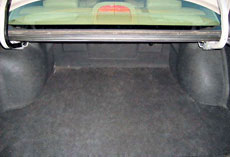 A lot of complaints also causes a suspension. By design, it resembles the younger Galant/Legnum model, and although Diamante provides good handling, it is still not as reliable as we would like. The levers are often summed up and without a special system, so it would be nice to sort out the suspension from time to time. In addition, the owners of such machines consider the hub bearings, which often for no reason fail to fail (the hubs, as expected, change in the collection during a breakdown).
A lot of complaints also causes a suspension. By design, it resembles the younger Galant/Legnum model, and although Diamante provides good handling, it is still not as reliable as we would like. The levers are often summed up and without a special system, so it would be nice to sort out the suspension from time to time. In addition, the owners of such machines consider the hub bearings, which often for no reason fail to fail (the hubs, as expected, change in the collection during a breakdown). Of course, Diamante has a lot of advantages: powerful motors, excellent (in kinematics and work) suspension, beautiful interior, interesting appearance, as well as all -wheel drive as an option. But is it worth it to go to the service centers so often? In general, this model needs to be greatly loved to take it for yourself. Moreover, it is better to buy a car from a Japanese auction in order to get a hard -ising copy in Russia (you can import either under the full duty or designer, which is risky). And still you need to be prepared for the fact that if there is a desire to sell the car, then this process will be very long (unless, of course, to ask for sane money for it, and not to give at a dumping price).
Some characteristics
Type of body sedan/station wagon
Number of doors 4/5
Sum of places 5
Length 4805/4810 mm
Width 1785 mm
Height 1435/1500 mm
Wheel base 2720 mm
Road clearance 155/165 mm
Max. speed 180 km/h* (limited by electronics)
* For the Japanese version.
The approximate cost of some spare parts*
Spare part price, rub.
Brake pads:
Front
rear
3000
2500
Shock absorbers (set):
Front
rear
14 000
9000
Spark plugs (set) 800
Filters:
oil
fuel
air
400
1500
700
Front Lower lever (1 pc.) 6000
Tip of steering thrust (1 pc.) 1000
Front wing 6000
Rear lamp 5000
Front bumper 12,000
Farah 9600
* For Diamante with a 6G72 engine.
The advantages and disadvantages of the model
Advantages
Affordable price
Harmonious appearance
Nice interior
Successful suspension settings
There are versions with the left wheel
Flaws
Low reliability
Dear spare parts
Great age of the model
Capricious motors GDI
Unsuccessful automatic automatic transmission
